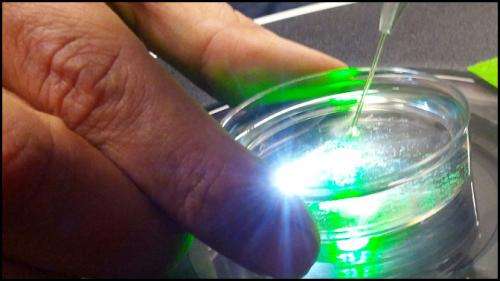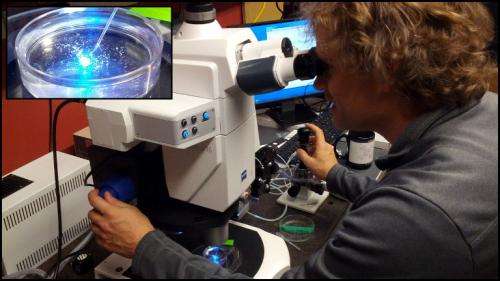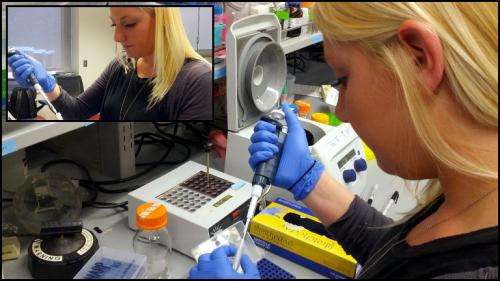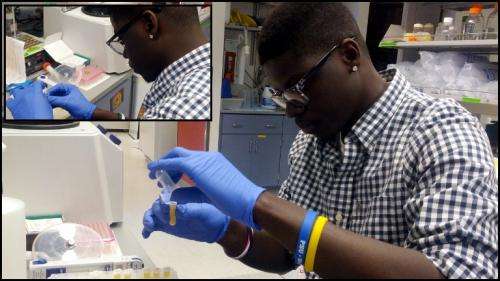Human heart beats using nearly billion-year-old molecular mechanism

(Phys.org) —We humans have been around for about 2.5 million years, but the beating of our hearts is controlled by something much older than Homo sapiens—an ancient molecular pathway that, according to Huck Institutes faculty researcher Tim Jegla, may be on the order of 700 million to a billion years old.
The Jegla Lab studies the evolution of the nervous and muscular systems, using model organisms such as the cnidarian Nematostella vectensis—also known as the starlet sea anemone—to investigate conserved traits and the molecular pathways and genes that underpin them.
According to Jegla, the starlet sea anemone is in essence an animal that's as evolutionarily far away from humans as possible while still sharing the same neuromuscular signaling systems. Comparisons of humans and cnidarians reveal that only the fundamentally important mechanisms are conserved—such as those required to make a neuron or, in this case, a neuromuscular signal.
"Basically," he says, "when we compare a human and a sea anemone, we're looking at somewhere between 700 million and a billion years' evolutionary separation. Anything that's not fundamentally critical to life as a mobile, multicellular animal is different. And the things we have in common were there in the nervous system of the animal we both evolved from; they were there in the ancestor of virtually all modern animal life other than sponges and comb jellies. Only the fundamental mechanisms are conserved. And this gives us a window into what things we have in common that are extremely important. It tells us a lot about the history of how animals evolved."
"We make the case in this paper," Jegla continues, "that the properties of the human Erg channel and the ancient Nematostella channel are tuned extremely well to repolarize the long action potentials that you need to get a strong muscular contraction, or a prolonged wave contraction like you have in a heartbeat. What we'd like to do now is to see if this kind of channel is fundamentally required to get that kind of wave contraction in all animals, and, if so, is that what it initially evolved for? If the slow wave contractions of the body wall are the functional orthologues of heart contraction, then have we adapted that whole preexisting program for the heart?
"All the other ion channels we use to regulate heart contraction are there, too, in Nematostella. So when we look at what this channel is doing in the human heart and what we can hypothesize it might be doing in the sea anemone, we can begin to see that maybe this is, in fact, what it evolved for."
Following on this study, Jegla has launched a new collaboration to further investigate the evolution of neuronal structure and signaling with colleague and fellow neurobiologist Melissa Rolls, director of the Huck Institutes' Center for Cellular Dynamics.
"We're collaborating with Melissa Rolls," Jegla says, "to look at not just how the channels and the signaling have evolved, but also how the structure of neurons themselves evolved, and when, why, and how axons and dendrites evolved. The sea anemone is an extremely interesting model organism for doing this, because it doesn't have a centralized nervous system; it has a diffuse nerve net that shows evidence of some bidirectional synapses, which makes it a great model organism for studying fundamental principles of how nerve cells are put together at the level of anatomy and signaling.

"The overall neuroanatomy of the sea anemone is much simpler than in other model organisms, so we think it's going to be much easier to correlate changes in neuronal activity with changes in behaviors and therefore to look into the fundamentally important, evolutionarily conserved cellular and molecular bases of behavior."
Cnidarians—comprising an ancient phylum that, in addition to sea anemones, includes animals such as jellyfish and corals—have nervous systems that allow them to coordinate movement and respond to their surroundings, but do not have a brain or any other analogous organs.

In a study recently published in Proceedings of the National Academy of Sciences, the Jegla Lab identified in the Nematostella sea anemone the same gene family (Erg) that is responsible for the slow-wave contractions of the human heart. After cloning the genes for further investigation, the researchers found that the ion channel it encodes has retained its function relatively unchanged since the time of humans' and cnidarians' divergence from their common ancestor almost a billion years ago.
"This discovery," says Jegla, "shows that at least some of the molecular mechanisms through which we control electrical activity in things like the heart evolved in some of the earliest animals, long before the existence of hearts or even cardiac tissue."

"This fits a broad pattern we're finding," Jegla continues, "that almost all the major signaling systems used in our brains and muscles evolved hundreds of millions of years ago in an ancestor of bilaterians which seems to have had a very versatile and molecularly complete set of tools for neuronal function that has been conserved throughout subsequent animal evolution and tuned to the specific needs of the major animal phyla. It appears that a lot of the signaling that we do in our complex neuromuscular systems is based on pre-existing programs that are just adapted to our specific physiological needs."
More information: "Functional evolution of Erg potassium channel gating reveals an ancient origin for IKr." Martinson AS, van Rossum DB, Diatta FH, Layden MJ, Rhodes SA, Martindale MQ, Jegla T. Proc Natl Acad Sci 2014 Apr 15;111(15):5712-7. DOI: 10.1073/pnas.1321716111. Epub 2014 Mar 31.
Journal information: Proceedings of the National Academy of Sciences
Provided by Pennsylvania State University





















